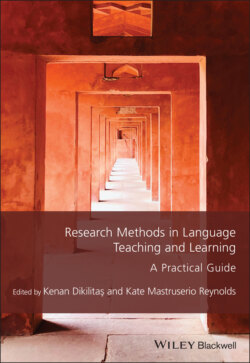Читать книгу Research Methods in Language Teaching and Learning - Группа авторов - Страница 34
Structured or Unstructured Diaries?
ОглавлениеA first key decision, therefore, was the extent to which the diaries should be structured or unstructured. Although ethnographic approaches aim to minimize the effects, disruptions, and distortions of the research process on participants’ experiences and understandings (Alaszewski, 2006, p. 78), the act of keeping a diary was, all the participants reported, a change in their behavior; none otherwise maintained a daily journal or record. Hence, a central tension was how to give the diarists control over what they recorded while recognizing my study’s own focus and goals; in other words, how to attain “relevant data without restricting [their] flow unnecessarily” (Mackrill, 2008, p. 8). Consequently, to what extent should diary entries be the participants’ own “free text” or be structured around a set of guidelines I might provide outlining what the diarists should record?
Thus, in an example of what Casanave (2017, p. 236) identifies as the “struggles, twists and turns” inherent in almost all research projects (but which are often smoothed over or overlooked in final publications), the guidelines to diarists in my study progressed from the former to the latter approach, developing and becoming slightly more structured during the early stages of data collection. Initially asking participants simply to record “anything you think was interesting,” this guidance became more focused at the request of the participants themselves, many of whom had felt slightly lost in the array of possible topics they might document (an example of the diarists themselves shaping the research; see above, “Finding Participants”). Consequently, I asked the participants to record events that stood out most during lessons and why they remembered them, and to talk about what I, as a researcher-observer in the classroom, “could not see, for example, what really goes on in pair work.” Although the diaries remained “open in structure, and informal” (Alaszewski, 2006, p. 78), the data subsequently became more immediately relevant to my research aims and objectives. The diary guidelines can therefore be understood as being as rather similar to interview guides, potentially creating a “dialogue” between the diarists and myself as the researcher (Mackrill, 2008), particularly as the diary entries formed the basis of the study’s follow-up interviews (see “Developing the Study” above). However, as noted at the start of this section, we should recognize that these guidelines inevitably affected, and are inseparable from, the collected data.
